National parks in Australia
National parks in Australia
Australia is known for having a large number of national parks, and has the most national parks anywhere with around 650 or so. However, it has a system that's very unusual, because most national parks are managed by the individual states and territories, not by the federal government, similar to the Netherlands or Quebec's provincial parks – the name "national" is a complete misnomer because they are all pretty much state parks. The few managed by the federal government are managed by Parks Australia.
National parks account for about 3% of Australia, accounting for about 350,000 km<sup>2</sup> of land – which is larger than the area of the United Kingdom, the Netherlands and Estonia combined or just a bit more than the area of Italy. Australia has the second largest amount of area protected as national parks, just behind Canada.
Understand
History
The concept of "national parks" quickly emerged with the world's second national park, Royal National Park, created soon after Yellowstone National Park was given special protection in the United States. However, Royal National Park was the first national park to use the "national park" title, so Royal NP is the first park to use the national park title as Yellowstone was previously called "Yellowstone Public Park" and until the 1950s, Royal National Park was just called "national park".
It started off with New South Wales, but then other British colonies were quick to implement national parks. Tower Hill National Park was Victoria's first national park in Victoria, Adelaide's Belair National Park became South Australia's first while Franklin-Gordon Wild Rivers National Park was Tasmania's first. Victoria's first national park was downgraded in the 1960s and today, it is only a nature reserve.
In 1901 during Australia's federation, national parks and land ownership remained with the states. That convention remains, which is why national parks are run by the states and territories, not by the federal government. However, some national parks are now managed by the federal government, including Australia's most famous ones like Ulu<u>r</u>u-Kata Tju<u>t</u>a, Kakadu and the Great Barrier Reef (though the GBR gets a bit complex) along with those in federal territories. However, even other popular or world heritage national parks such as Purnululu in Western Australia, Budj Bim in Victoria, Ikara-Flinders Ranges in South Australia, Blue Mountains in NSW or pretty much any other national park are pretty much state parks.
Today, Australia's national parks system is often a controversial one. It is often compared to the national parks system in the United States and Canada – two countries that have a similar size, geography and culture — and is often criticized for it. There have been several proposals to make a reputable national parks system in Australia, though none have been implemented.
However, Australia does have a "National Reserve System", which is a part of the National Reserve System Cooperative Program, in which is a cooperated program between the federal government and the states and territories which effectively manages to conserve the treasures of Australia.
Some parks such as Ulu<u>r</u>u or Mungo today are now managed by a joint management program, meaning that the park is managed by the respective parks department alongside Indigenous elders. Joint management programs have been starting to appear in many national parks regardless of where it's located. This is on top of Indigenous Protected Areas, comanaged by the federal government and the Indigenous people.
Climate
Australia is far too big a country to give an overall description of its national parks, but in general:
- the parks in the north such as Kakadu or the Daintree are often best visited during the dry season (during southern winter/northern summer) and may be open with disruptions while others like Purnululu National Park are completely shut off during the wet season.
- the parks in Central Queensland or the Pilbara are best visited in winter, similar to those in the north as cyclones regularly hit the regions on both sides. In Queensland, jellyfish also roam the waters and some national parks prohibit swimming or snorkelling.
- in more central parks such as the Mid-West region in Western Australia, anytime of the year is suitable
- in south-central national parks such as the region north of NSW is best visited in autumn/fall or spring. Sometimes winter may be too cold, while summer may be too hot
- parks in the south (most of Victoria and Tasmania along with some parts of Western Australia) are best visited during summer. Sometimes Tasmania's national parks are inaccessible and others such as in Victoria are just too cold.
- parks in the outback regardless of state should only be visited in winter. Visiting in summer is just far too hot and some are closed (often from Dec 1 to Mar 15).
Get in
As there are many national parks in Australia, it's not exactly possible to give an overall description on how to get in, but accessibility significantly varies across the country. Some like Royal National Park or Blue Mountains National Park have regular scheduled transport with others like Ku-ring-gai Chase National Park don't have public transport but are still easily accessible by car.
However, most of Australia's national parks are only accessible by gravel roads, which can often be of poor quality, and some are located in areas so remote that there are no roads leading there at all; the only way to access them is off-road driving in a four-wheel drive. Be sure to stock up an ample supply of food, water and fuel before attempting to reach one of these, and it is highly recommended that you rent a satellite phone in case of emergencies despite the high cost involved. See the relevant articles for details on how to get into each one.
National parks
There are too many national parks to list here, but these ones are the ones that are either most well known or have some sort of significance. See the relevant state articles for a full list of parks in that jurisdiction.
In some cases, a conservation reserve or a recreation park may be more famous than a national park – such include the World Heritage listed Jenolan Caves Karst Conservation Reserve much much more well known and touristed than Abercrombie River National Park, which is not very far from the karst conservation reserve, albeit it being a "national park".
Queensland, Western Australia and South Australia also have conservation parks, which are also protected areas of outstanding natural beauty, but are not considered to be of enough national significance to be declared national parks. Many of these are also popular tourist attractions.
Australian Capital Territory
- Namadgi National Park – the only national park in the ACT, and the northernmost of all the Australian Alps National Park covering about 47% of the Australian Capital Territory.
New South Wales
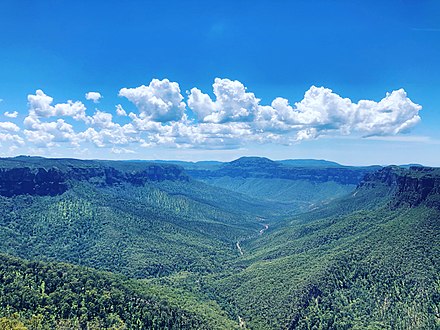
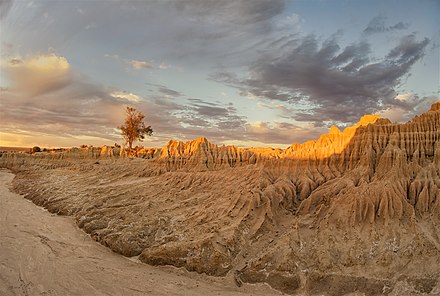
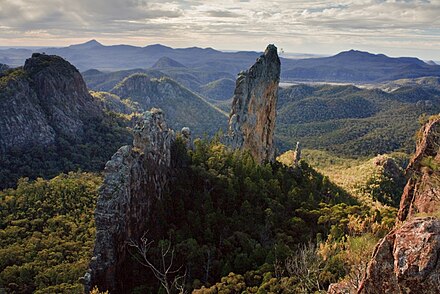 See also: New South Wales national parks
See also: New South Wales national parks
- Barrington Tops National Park
- Ben Boyd National Park
- Blue Mountains National Park – NSW's most visited national park
- Budderoo National Park – the last remains of rainforest in the Illawarra
- Dorrigo National Park
- Kamay-Botany Bay National Park – home to the site of Captain Cook's landing in Botany Bay
- Kanangra-Boyd National Park
- Kosciuszko National Park – largest park in the state home to vast alpine landscapes, ski resorts and the highest mountain on the Australian mainland
- Ku-ring-gai Chase National Park – home to some rock artworks and several hiking trails and a popular place for boating
- Wollumbin National Park – the world's largest extinct shield volcano
- Mungo National Park – a UNESCO World Heritage Listed park as part of the Willandra Lakes Region home to the world's oldest cremated body and the Walls of China formation
- New England National Park – a UNESCO World Heritage Listed park as part of the Gondwana Rainforests of Australia containing some of the oldest subtropical forests over 1500-metre mountains
- Oxley Wild Rivers National Park – a UNESCO World Heritage Listed park as part of the Gondwana Rainforests of Australia
- Royal National Park – the world's second national park
- Sydney Harbour National Park
- Warrumbungle National Park – see the firsthand breadknife shaped rock wonder
- Wollemi National Park
Northern Territory
Main article: National parks in the Northern Territory
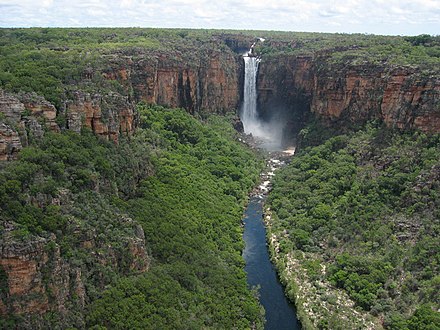 The Northern Territory has seventeen national parks, which is still quite a lot for its size. Of those seventeen, two of them; Uluru-Kata Tjuta and Kakadu National Parks are UNESCO World Heritage Sites and are managed by the federal government. The rest of them are managed by the territory government. Similar to South Australia or Tasmania, the Northern Territory only reserves "national parks" for the finest and has a system of conservation reserves and parks below national parks.
The Northern Territory has seventeen national parks, which is still quite a lot for its size. Of those seventeen, two of them; Uluru-Kata Tjuta and Kakadu National Parks are UNESCO World Heritage Sites and are managed by the federal government. The rest of them are managed by the territory government. Similar to South Australia or Tasmania, the Northern Territory only reserves "national parks" for the finest and has a system of conservation reserves and parks below national parks.
Even though the NT only has seventeen national parks, it is sometimes considered "too many" by some. The Northern Territory is of similar size of the Canadian province of Quebec, but Quebec only has three national parks, about a sixth of how much parks in the Northern Territory (this number does not include Quebec's "provincial national parks").
- Kakadu National Park
- Litchfield National Park
- Nitmiluk National Park
- Tjoritja / West MacDonnell National Park
- Uluṟu-Kata Tjuṯa National Park – Australia's most iconic park
- Watarrka National Park – home to the reasonably sized and very reddish Kings Canyon, and a popular detour visited by those driving from Alice to Ulu<u>r</u>u.
Queensland
 See also: Queensland national parks
See also: Queensland national parks
- Boodjamulla National Park
- Bunya Mountains National Park
- Carnarvon National Park
- Daintree National Park
- Glass House Mountains National Park
- Great Sandy National Park
- Lamington National Park
- Undara Volcanic National Park
- Whitsunday Islands National Park
Although the Great Barrier Reef Marine Park isn't exactly a national park, it is treated as a national park. Other than the GBR Marine Park, the Great Barrier Reef has some national parks within it such as Capricornia Cays National Park.
South Australia

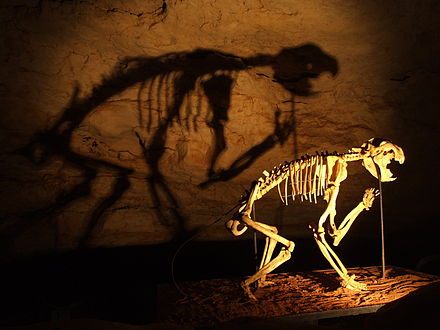 See also: South Australian national parks
See also: South Australian national parks
South Australia is the only Australian mainland state that limits its national parks to what is nationally significant. It has a system of conservation reserves, wildlife reserves, etc., for parks that aren't as nationally significant, and so it is why it has fewer national parks than the 200 or so that New South Wales or Queensland have.
However, even that may be considered "a lot" by some. South Australia is roughly around the size of Ontario in Canada, yet Ontario has only five, compared to South Australia's 28 or so. (However, Ontario also has more than 300 provincial parks, but South Australia has many conservation and recreational reserves.)
- Belair National Park — the most easily accessible national park in the state, at the edge of the Adelaide metropolitan area. Today it is a popular picnic and barbecue spot for locals, and home to an abundance of wild rainbow lorikeets and Pacific black ducks. The park is also South Australia's first national park, and contains some historic buildings. Belair NP was SA's first national park, the second in Australia, and the 10th in the world.
- Coorong National Park — an important cultural site for the indigenous Ngarrindjeri people and one of the world's longest beaches
- Flinders Chase National Park – a must for anyone visiting Kangaroo Island and a popular seal-watching spot
- Ikara-Flinders Ranges National Park – South Australia's most iconic national park, and on UNESCO's tentative list.
- Munga-Thirri–Simpson Desert National Park – Australia's largest national park
- Naracoorte Caves National Park – South Australia's only World Heritage national park home to one of Australia's largest fossil deposits
- Nilpena Ediacara National Park – home to a lot of fossils from the Ediacaran era, well before dinosaurs roamed the planet. It is on UNESCO's tentative list.
- Nullarbor National Park – an open, vast area with just nothing in sight
- Vulkathunha-Gammon Ranges National Park – a northerly national park in the Flinders Ranges. A popular scenic spot and has many bushwalking trails.
Tasmania
 See also: Tasmanian national parks
See also: Tasmanian national parks
Tasmania is the only state to be mostly covered in wilderness with 42% of its land protected. A quarter of the state is a world heritage site, as part of the Tasmanian Wilderness World Heritage Area, which accounts for a little less than half of all Tasmanian national parks. Similar to South Australia, Tasmania too has a graded system of what becomes a "national park" and what is called a conservation reserve and a range of other types of parks and so it has a reasonable number of national parks for its geography.
- Cradle Mountain-Lake St Clair National Park – home to Cradle Mountain and Lake St. Clair, two iconic landscapes of Tasmania
- Franklin-Gordon Wild Rivers National Park – more vast wilderness
- Freycinet National Park – known for its beachside landscape
- Mole Creek Karst National Park – Tasmania's only national park protecting a karst landscape
- Mount Field National Park – home to several glacial lakes and a skiing resort
- Southwest National Park – covers almost 10 percent of the state in wilderness and home to one of the most isolated but yet good-looking fjord
- Tasman National Park – home to some of the highest dolerite cliffs anywhere in the world
Victoria

%2C_Port_Campbell_National_Park%2C_Twelve_Apostles_--_2019_--_0930.jpg/440px-Princetown_(AU),_Port_Campbell_National_Park,_Twelve_Apostles_--_2019_--_0930.jpg) See also: Victorian national parks
See also: Victorian national parks
- Alpine National Park – Victoria's largest national park and pretty much a continuation of Kosciuszko National Park
- Baw Baw National Park – one of the most accessible Australian Alps National Parks
- Budj Bim National Park – Victoria's only world heritage park, home to the world's oldest aquaculture system
- Croajingolong National Park – a UNESCO Biosphere Reserve with many coastal dunes and sandy beaches
- Great Otway National Park – one of Victoria's greatest parks on the Great Ocean Road
- Grampians National Park — known for being home to numerous unique plant species, and as a major Aboriginal cultural site
- Murray Sunset National Park – another Pink Lake lies here
- Port Campbell National Park – you may not have heard of the park's name, but you might probably be familiar with the park's main POI, the 12 Apostles, often considered the natural icon of Victoria
- Wilsons Promontory National Park – Victoria's longest continually existing national park and the southernmost point of the Australian mainland
Western Australia
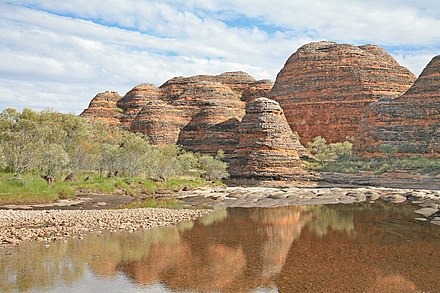
- Cape Le Grand National Park
- Cape Range National Park
- Francois Peron National Park – where desert really meets the ocean
- Kalbarri National Park – home to its fine landscape
- Karijini National Park – has one of Western Australia's most unusual waterfalls
- Leeuwin-Naturaliste National Park – known for its many caves and its two capes
- Murujuga National Park – one of the world's densest collections of rock art
- Nambung National Park – home to the unusual "Pinnacles Desert"
- Purnululu National Park – a world heritage national park home to the unusual yet unique Bungle Bungle ranges
- Wolfe Creek Crater National Park – one of the best preserved meteorite craters but less than 120,000 years old
Other jurisdictions
 There are four national parks in Australia to be located on other federal territories. One of them is on the mainland, while the others are located on offshore territories.
There are four national parks in Australia to be located on other federal territories. One of them is on the mainland, while the others are located on offshore territories.
- Booderee National Park
- Christmas Island National Park
- Norfolk Island National Park
- Pulu Keeling National Park (North Keeling)
See
Many national parks that are heavily touristed or have some great natural scenery or views will often have at least one or two lookouts, but many national parks have a lot more than one. Some of them are right beside a carpark or some sort of road access, while others require a bit of a hike.
In other cases, you may be allowed to go very close up to whatever you're intending to look at. Often this isn't an option for most heavily touristed parks, but in some cases like the Three Sisters in Blue Mountains National Park, you can actually go to the very edge of the rock formation.
Even if there are no lookouts to whichever park you're heading to, the landscape itself may be something to see.
Apart from lookouts and the landscape, some national parks may have some sort of historical site in it. These can either be from the colonial times of Australia, or a site that is significant to Indigenous Australians, or a mixture of both.
Do
Hiking
See also: Hiking and bushwalking in Australia
Nearly all national parks have at least one hiking or walking trail, even tiny ones like Malabar Headland National Park (which would be no more than your ordinary neighbourhood park), and they are very prominent. In most cases, it is possible to download a map off the relevant jurisdiction's national park website, but if not, there will be some sort of topographic map online. The biggest exception is in the desolate parks in the Outback (something like Munga-Thirri National Park, not Uluru or Ikara-Flinders Ranges), and hiking in such remote places are often discouraged and often there will not be a single walking trail – this is deliberately done for safety reasons.
Fishing
In coastal or riverside national parks (but not marine parks or the GBR), you may be allowed to fish certain types of fish. However, make sure to check local fishing guidelines and laws, as if you end up catching a fish that's endangered (even in an area where fishing is permitted), you could end up with a hefty fine. However, it's not very common to keep the fish, and most people will just catch and then release the fish.
Caving
In those parks which have caves, you may be allowed to go caving. Some caves require tours, some are self guided, and others require a permit in advance. See the relevant park article for how to visit the caves (if the park has them).
Eat
Very few national parks have some sort of cafe, restaurant, kiosk or any place to eat in the first place. Most will have some sort of picnic table or two, but otherwise, you will generally have to bring your own food. However, many national parks are within close proximity of a nearby town, an alternative if you want some hot food or simply don't want to bring some food with you.
Some parks might have some sort of local specialty, such as Kakadu National Park for crocodile or the Kakadu Plum, while Daintree National Park is known for its rainforest ingredients. This is not a common occurrence in most parks, but if you're at one that has one, they're often worth a try.